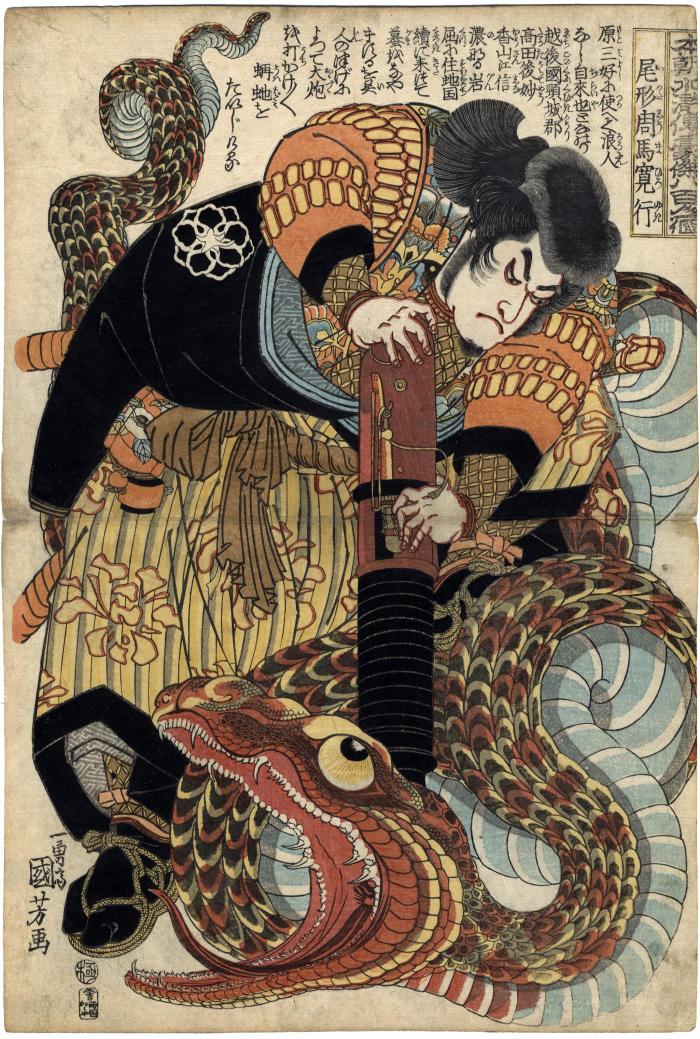Utagawa Kuniyoshi (歌川国芳) (artist 11/15/1797 – 03/05/1861)
Ogata Shūma Hiroyuki (尾形周馬寛行) from the series Eight Hundred Heroes of the Japanese Shuihuzhuan (Honchō Suikoden gōyū happyakunin no hitori - 本朝水滸伝剛勇八百人一個)
ca 1830
10.125 in x 15 in (Overall dimensions) Japanese woodblock print
Signed: Ichiyūsai Kuniyoshi ga
一勇斎国芳画
Publisher: Kagaya Kichiemon
(Marks 195 - seal 22-027)
Censor's seal: kiwame
Museum of Fine Arts, Boston - dated ca. 1830
National Museum of Asian Art
Waseda University - a completely different representation from 12/1866 by Yoshiiku of Ogata Shūma Hiroyuki
Kunstpalast Düsseldorf
Art Gallery of South Australia "Although brief, the inscription on the design provides an important clue to understanding the image. It notes that the subject, Ogata Shūma Hiroyuki (life dates unknown, Muromachi-period), later known as Jiraiya, is killing the snake because it was terrorizing his friends the frogs. For early-nineteenth-century print consumers, snakes, frogs, and the name Jiraiya would have evoked an unusual tale of esoteric magic and encounters with the supernatural."
"In his youth, Jiraiya escaped certain death by joining a gang of bandits as his father's domain fell to invading forces. After a brief apprenticeship with his criminal associates, Jiraiya soon became the leader of the gang. While on his way to rob a wealthy nobleman, Jiraiya was forced to seek shelter from a snowstorm in the hut of an old woman. During the night, he attempted to murder his host, but his sword shattered. The old woman was actually Gamma Sennin, the toad spirit, who offered to teach Jiraiya toad magic, if he renounced his evil ways. Jiraiya agreed and thereafter had the ability to control frogs. He later teamed up with Tsunedahime, a young woman who had mastered snail magic. Together they killed Orochimaru, the evil son of a giant serpent."
"The Jiraiya, Tsunedahime, and Orochimaru legend became the basis of a popular game known as sansukumi, or the "three crouching ones." It was played in much the same manner as scissors, rock, and paper is today. Participants counted three times, then formed their hands in the shape of a snake, frog, or snail. According to the rules of the game, the snake devours the frog, the frog eats the snail, and the slime of the snail is poisonous to the snake."
"The exotic weapons wielded with finesse and often brutal consequences by the Chinese heroes featured in Kuniyoshi's early Suikoden series... contributed tremendously to the popularity of those designs. The weapon used by Japanese heroes were obviously more familiar to warrior print consumers, but Kuniyoshi always seemed to find interesting ways to deploy them. In this print, the exceptionally large gun Jiraiya is about to jam behind the skull of the serpent provides the focal point of this design and the primary axis around which Kuniyoshi constructed this composition."
Quoted from: Masterful Illusions... (see below), entry by Allen Hockley, p. 206.
****
Basil Robinson wrote in 1982: "Ogata Shuma Hiroyuki (later known as Jiraiya), with a heavy gun, overcoming a huge snake which had preyed on his friends the toads."
****
Illustrated in:
1) in Ukiyo-e dai musha-e ten - 浮世絵大武者絵展 - (The Samurai World in Ukiyo-e), edited by Yuriko Iwakiri, Machida City Museum of Graphic Arts, 2003, #161, p. 61.
2) In black and white in Chimi moryō no sekai : Ukiyoe : Edo no gekiga--reikai, makai no shujinkō-tachi (浮世絵魑魅魍魎の世界: 江戶の劇画 : 霊界魔界の主人公たち) by 中右瑛 (Nakau Ei), Ribun Shuppan, Tokyo, 1987, p. 67. [The text is entirely in Japanese.]
3) In a full page color reproduction in Masterful Illusions: Japanese Prints in the Anne van Biema Collection, University of Washington Press, 2002, page 207.
4) In color in Japanese Yōkai and Other Supernatural Beings: Authentic Paintings and Prints of 100 Ghosts, Demons, Monsters and Magicians by Andreas Marks, Tuttle Publishing, 2023, p. 176. Also, in a smaller black and white reproduction on page 127, #218.
5) in a large color reproduction in Ukiyo-e: Japanische Farbholzschnitte des 19. Jahrhunderts, Schenkung Dr. Hans Lühdorf. Bilder einer fließenden vergänglichen Welt., Kunstmuseum Düsseldorf im Ehrenhof, 1990, tafel IV, #218. On page 127 a smaller black and white reproduction of this print along with a description. The text reads: "Ogata Shuma Hiroyuki, später bekannt als Jiraiya, besiegt mit einer Mörserkanone auf dem Berg Kosan bei Chunano in der Provinz Echigo." The Google translation reads: "Ogata Shuma defeats Hiroyuki, later known as Jiraiya, with a mortar cannon on Mount Kosan near Chunano in Echigo Province."
Note that the cover of this catalog shows an enlargement of the head of this hero and its immediate surroundings. More of the enlarged details of this print continue onto the spine and the back of the catalog, too
6) in color in Utagawa Kuniyoshi: 342 Color Paintings [sic] of Utagawa Kuniyoshi by Jacek Michalak, Kindle Edition, 2022, unpaginated.
Kagaya Kichiemon (加賀屋吉右衛門) (publisher)
warrior prints (musha-e - 武者絵) (genre)
Yūrei-zu (幽霊図 - ghosts demons monsters and spirits) (genre)
Suikoden (水滸傳) (genre)
magicians (mahōtsukai - 魔法使い) (genre)
Jiraiya (自来也) (role)
